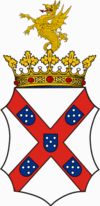- Children of Palhavã
-
The children of Palhavã (Portuguese Meninos de Palhavã) were three male natural sons of King John V of Portugal (1706–1750), which were recognised by the monarch in a document issued in 1742, which was published only after the death of the king, in 1752.
The expression comes from the fact these three children had lived in the palace of the Marquis of Louriçal, in the Palhavã area, in those times outside Lisbon. Today, this building is within the city limits and it is occupied by the Spanish Embassy.
The children had a remarkable education in the Santa Cruz Monastery, in Coimbra. Their master was Friar Gaspar da Encarnação, who educated them as religious men according to the late King's wishes.
The three children of Palhavã were:
- Anthony (D. António) (1704–1800) - his mother was an unknown French lady. He became Doctor in Theology and later knight of the Order of Christ;
- Casper (D. Gaspar) (1716–1789) - his mother was a nun (Madelein Máxima de Miranda). He became archbishop of Braga.
- Joseph (D. José) (1720–1801) - son of Mother Paula, abbess of the Monastery of Saint Denis of Odivelas. He became General Inquisitor of Portugal.
In spite that they were King Joseph I's half brothers, Anthony and Joseph were exiled to Buçaco in 1760 due to a conflict with the Marquis of Pombal, the all-mighty prime minister. They were allowed to return to the Court only after the king's death, in 1777.
See also
- John V of Portugal
- Joseph I of Portugal
- Marquis of Pombal
- Archdiocese of Braga
Categories:- Portuguese monarchs
- Dukes of Braganza
- House of Braganza
- Illegitimate children of Portuguese monarchs
- Portuguese people stubs
- Portuguese royalty stubs
Wikimedia Foundation. 2010.

